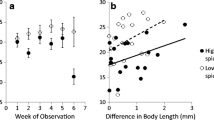Summary
The distribution of the spider Zygiella x-notata was examined using field populations of adult females occupying the outside frames of windows. The structure of the populations was aggregative, and the distribution of individuals on the window frames and the size of the webs were density dependent. Also, the sizes of the webs of neighbouring spiders on the same window alternated. This spatial organization involves interactions between neighbours. If one spider out of two is removed, and if all the webs are destroyed, remaining spiders that previously had small webs significantly increase the size of their construction. In contrast, individuals that previously had large webs do not modify the size of their construction. This shows that individuals of Z. x-notata respond to the presence of neighbours. The influence of intraspecific interactions in such a population is discussed.
Similar content being viewed by others
References
Burgess JW (1979) Measurement of spatial behavior; methodology applied to Rhesus monkeys, Neon tetras, communal and solitary Spiders, Cockroachs and Gnats in open fields. Behav Neur Biol 26:132–160
Burgess JW, Uetz WG (1982) Social spacing in spiders. In: Witt PN, Rovner JS (eds) Spider communication: mechanisms and ecological significance. Princeton University Press, pp 318–351
Buskirk RE (1975a) Coloniality, activity patterns and feeding in a tropical orb-weaving spider. Ecology 56:1314–1328
Buskirk RE (1975b) Aggressive display and orb defence in a colonial spider Metabus gravidus. Anim Behav 23:560–567
Buskirk RE (1981) Sociality in the Arachnida. In: Hermann H (ed) Social Insects. Vol II, Academic Press, New York, pp 281–367
Campbell DJ, Clark DJ (1971) Nearest neighbour tests of significance for non randomness in the spatial distribution of singing crickets (Teleogryllus commodus, Walker). Anim Behav 19:750–759
Crips DJ (1979) Territorial behaviour in barnacle settlement. J Exp Biol 38:429–446
Davies NB (1978) Ecological questions about territorial behaviour. In: Krebs JR, Davies NB (eds) Behavioural ecology, an evolutionnary approach. Blackwell Scientific Publication, Oxford pp 315–350
Krafft B (1979) Organisation et évolution des sociétés d'Araignées. J Psychol 1:23–51
Lahmann BS, Eberhard WG (1979) Factores selectivos que afectan la tendencia a agruparse en la araňa colonial Philoponella semiplumosa (Araneae, Uloboridae). Rev Biol Trop 27:231–240
Leborgne R, Pasquet A (1987) Influence of conspecific silkstructures on the choice of a web-site by the spider Zygiella x-notata (Clerck). Rev Arachnol (in press)
Pasquet A (1984) Repartition de deux espèces d'Araignées orbitèles, Araneus marmoreus (Clerck) et Araneus diadematus (Clerck) dans une prairie en friches. Biol Behav 9:321–331
Pasquet A, Leborgne R (1985) Partage de l'espace chez quelques espèces d'araignées solitaires: approche éthologique. Bull Ecol 16:89–93
Pasquet A, Leborgne R (1985) Etude préliminaire des relations prédateur-proies chez Zygiella x-notata (Araneae, Argiopidae). CR Soc Biol 180:347–353
Pielou EC (1960) A single mechanism to account for regular, random and aggregated populations. J Ecol 48:575–584
Riechert SE (1978) Games spiders play: I. Behavioral variability in territorial disputes. Behav Ecol Sociobiol 3:135–162
Riechert SE (1979) Games spiders play: II. Resource assessment strategies. Behav Ecol Sociobiol 6:121–128
Riechert SE (1981) The consequences of being territorial spiders: a case study. Am Nat 117:871–892
Riechert SE, Reeder WG, Allen TA (1973) Pattern of spider distribution (Agelenopsis aperta Gertsch) in desert grassland and recent lava bed, south central New-Mexico. J Anim Ecol 42:19–35
Rypstra AL (1979) Foraging flocks of spiders. A study of aggregate behavior in Cyrtophora citricola (Araneae, Araneidae) in West Africa. Behav Ecol Sociobiol 5:291–300
Rypstra AL (1985) Aggregation of Nephila clavipes (L.) (Araneae, Araneidae) in relation to prey availability. J Arachnol 13:71–78
Schoener TN, Toft A (1983) Dispersion of the small-island population of the spider Metepeira datoma (Araneae, Araneidae) in relation to web-site availability. Behav Ecol Sociobiol 12:121–128
Siegel S (1956) Nonparametric statistics for the behavioral sciences. McGraw-Hill, New York
Smith DRR (1983) Ecological costs and benefits of communal behavior in a presocial spider. Behav Ecol Sociobiol 13:107–114
Uetz GW, Kane TC, Stratton GE (1982) Variation in the social group tendency of a communal web-building spider. Science 217:547–549
Author information
Authors and Affiliations
Rights and permissions
About this article
Cite this article
Leborgne, R., Pasquet, A. Influences of aggregative behaviour on space occupation in the spider Zygiella x-notata (Clerck). Behav Ecol Sociobiol 20, 203–208 (1987). https://doi.org/10.1007/BF00299734
Received:
Accepted:
Issue Date:
DOI: https://doi.org/10.1007/BF00299734




